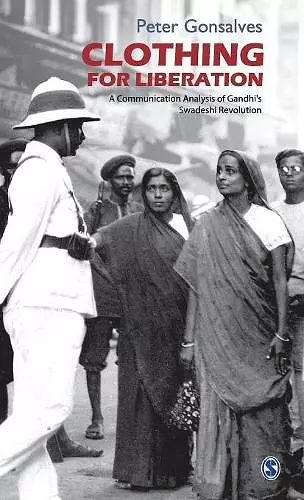Clothing for Liberation
A Communication Analysis of Gandhi′s Swadeshi Revolution
Format:Hardback
Publisher:SAGE Publications India Pvt Ltd
Published:17th Feb '10
Currently unavailable, and unfortunately no date known when it will be back

This is the first analysis of Gandhi′s dressing style in terms of communication theory and an exploration of the subliminal messages that were subtly communicated to a large audience. Peter Gonsalves chooses three famous theorists from the field of communication studies and looks at Gandhi through the lens of each one, to give us a fascinating and new insight into one of the most famous men from South Asia.
The author first prepares the ground for the theoretical investigation by exploring the breadth of Gandhi′s communication skills. He provides essential information on a wide range of Gandhi′s communication skills, with a view to proposing interesting areas of research for communication scholars.
The book deals with the qualitative and quantitative aspects of Gandhi′s verbal output, his linguistic capacity, his journalistic and letter-writing style, his peace communication in an atmosphere of conflict, his organizational ability and the international repercussions of his mass mediated messages. It also elaborates the different types of non-verbal communication he used, such as silence, fasting, clothing, personal presence and charisma. The book closes with, perhaps for the first time, a Gandhian approach to symbolisation for socio-political change.Photographs of Gandhi in different phases of his life have been used to provide a visual chronology of sartorial change and emphasise the arguments in the book.
Gonsalves makes you see Gandhi in an academic light that permits you to both name some of the characteristics of Gandhi and see them in the larger perspectives of communication and revolution for liberation. This exercise, that at first might appear an indulgence in scholarly rationalizations, in fact gives a solid foundation to the conviction experienced at the end of Chapter 1 as to the greatness of Mahatma Gandhi. At the end of the book, that conviction is no longer superficial....After reading this book, I, for one, can only say: Looking afresh at Gandhiji, I know in the depth of my being what he means: "another world is possible." -- Gaston Roberge, Educationist and Media Critic
Mahatama Gandhi used Khadi less as garment and more as a message to both Indians and the British. This is the sum of Peter Gonsalves’ Clothing for Liberation. The author shows how Gandhi became, perhaps, the best communicator of his age. The sheer simplicity of clothing (or fabric) as a medium of this communication, he shows, was an act of genius. -- Businessworld
The book is an immensely insightful resource for students of communication, politics, history and semiotics.
-- Deccan ChronicleClothing was an important symbol that Gandhi deployed to communicate and unite people divided by religion, caste, language and ethnicity. Clothing for Liberation seeks to unravel Gandhi and the symbolism in his clothing to understand the non-violent movement that humbled a mighty empire.
-- The Times of IndiaThe book is useful since Gandhi as a symbol maker has a lot to teach contemporary symbol makers like parents, educators, social workers, activists and politicians how to go about working for a better world, making effective use of non-verbal symbols. The book has a bibliography and index which should be of help to future researchers wanting to work on Gandhi and/or communication technology.
-- Freedom FirstThe book investigates the communicative power of Gandhi’s style of dressing and use of home-spun cloth for staging a revolution involving over 300 million people…The book deals with the qualitative and quantitative aspects of Gandhi’s verbal output, his linguistic capacity, his journalistic and letter-writing style, his peace communication in an atmosphere of conflict, his organizational ability and the international repercussions of his mass mediated messages. It also elaborates the different types of non-verbal communication he used, such as silence, fasting, clothing, personal presence and charisma.
-- Press Trust of IndiaThe book is neither a political/historical documentation nor a biographical sketch. It presents Gandhi as a communicator and, more importantly, as an embodiment of the symbols that shaped the course of history. By highlighting Gandhi’s non-verbal communication through a radical choice of clothing, the author endows history with a new political, economic, psychological, social and cultural significance. This book is written with the conviction that Gandhian ideology is and will remain a crucial element of Indian consciousness as a nation…. The tone of his book is patient and friendly, playfully moderating an academic authority which Gonsalves certainly possesses.
-- DawnISBN: 9788132103103
Dimensions: unknown
Weight: 350g
188 pages